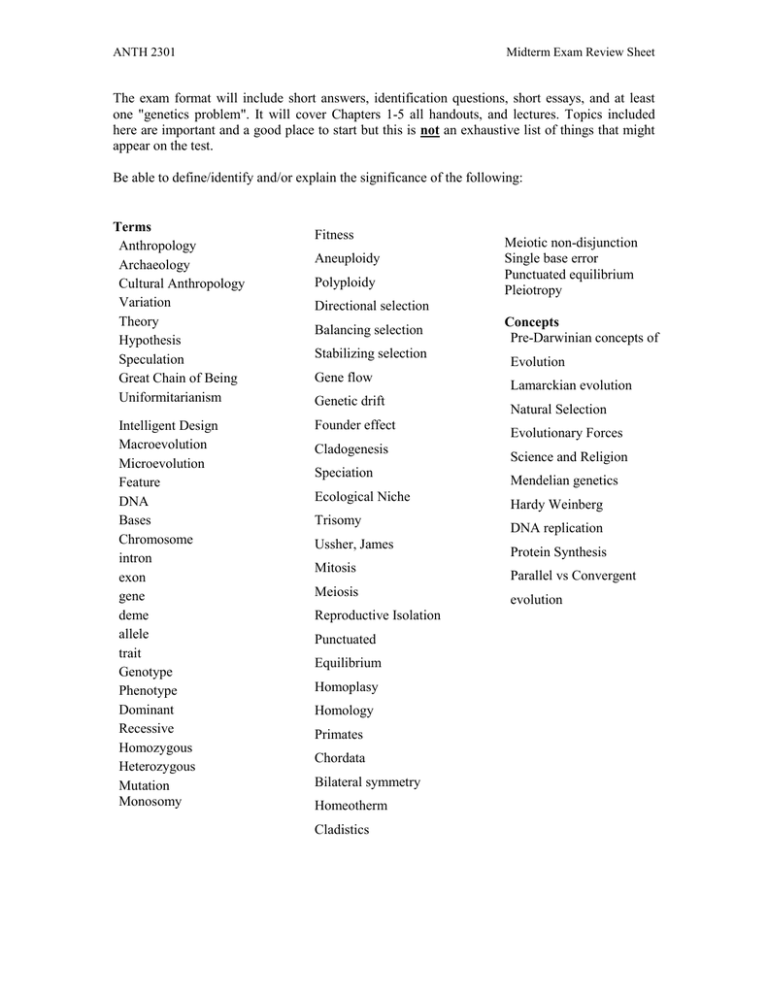ANTH 2301 Midterm Review Sheet Spring 2016.doc
advertisement

ANTH 2301 Midterm Exam Review Sheet The exam format will include short answers, identification questions, short essays, and at least one "genetics problem". It will cover Chapters 1-5 all handouts, and lectures. Topics included here are important and a good place to start but this is not an exhaustive list of things that might appear on the test. Be able to define/identify and/or explain the significance of the following: Terms Anthropology Archaeology Cultural Anthropology Variation Theory Hypothesis Speculation Great Chain of Being Uniformitarianism Intelligent Design Macroevolution Microevolution Feature DNA Bases Chromosome intron exon gene deme allele trait Genotype Phenotype Dominant Recessive Homozygous Heterozygous Mutation Monosomy Fitness Aneuploidy Polyploidy Meiotic non-disjunction Single base error Punctuated equilibrium Pleiotropy Directional selection Balancing selection Stabilizing selection Gene flow Genetic drift Founder effect Cladogenesis Speciation Ecological Niche Trisomy Ussher, James Mitosis Meiosis Reproductive Isolation Punctuated Equilibrium Homoplasy Homology Primates Chordata Bilateral symmetry Homeotherm Cladistics Concepts Pre-Darwinian concepts of Evolution Lamarckian evolution Natural Selection Evolutionary Forces Science and Religion Mendelian genetics Hardy Weinberg DNA replication Protein Synthesis Parallel vs Convergent evolution ANTH 2301 Midterm Exam Review Sheet Genetics problems: 1) Imagine there is a locus with two alleles, H and h, where H is dominant and is the “hairy nose” allele. If a man with genotype HH mates with a woman with genotype hh, the proportion of offspring expected to have the “hairy nose” phenotype is… 2) The ABO blood group has three alleles (A, B, O). If a woman with genotype AO mates with a man with genotype BB, the expected proportion of heterozygotes among their offspring is… 3) There is a blood-type related gene known as MN, which provide certain antibodies. There are two alleles for this gene which are co-dominant: M and N. Consider a population that has 50 people with genotype MM, 100 people with genotype MN, and 50 people with genotype NN. What are the genotype frequencies of this population? 4) The MN blood group has two co-dominant alleles. How can a woman with type M blood have a child with type N blood? 5) In terms of the MN blood group, assume a population that has 49 people with genotype MM, 42 people with genotype MN, and 9 people with genotype NN. What is the frequency of the M allele in this population? 6) Imagine a locus with two alleles – A and a. Assume a population that has 25 people with genotype AA, 50 people with genotype Aa, and 25 people with genotype aa. How many M alleles are in the population? 7) Imagine a locus with two alleles, F and G. If the frequency of the F allele is 0.6, then the frequency of the G allele must be… 8) Assume two alleles, A and B, at a given locus. If the frequency of the A allele is 0.6 and the frequency of the a allele is 0.4, the expected genotype frequencies are:







